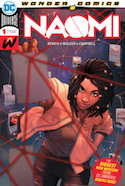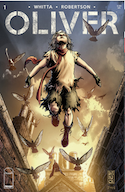Thursday Comics Hangover: A pair of orphans

Two weeks ago, I gushed over the first issue of Brian Michael Bendis's Young Justice. Today, I'm gushing over the first issue of another book from Bendis's Wonder Comics line of superhero comics for young readers.
Naomi is the story of a young woman whole world is upended when Superman fights a bad guy in her small Oregon town. That superhero battle — just a handful of seconds in a planet-spanning fistfight with the villain Mongul — causes Naomi to start asking questions about her town. By the end of the issue, we don't have any answers, but it's clear that she's onto something big.
It's pretty clear that Bendis, who co-wrote the script with David F. Walker, is feeling reinvigorated from his recent move from Marvel to DC Comics. He's one of the best Superman writers of this generation — as in Bendis's other books, his Superman is kind and optimistic and trustworthy — and his Wonder Comics line offers a cheery and upward-facing look into the huge, ridiculous, complex world of DC Comics.
But as great as the writerly components are, Naomi wouldn't be the standout it is without Jamal Campbell's artwork. The polish and detail in every panel of Naomi rewards close investigation — you get the sense that Campbell has laid out every street of Naomi's town. Every detail in the art and colors, from the Pacific Northwest grey skies to the warm glow of a forest sunset, feels deeply considered and thoroughly impressive. I'm entirely on board for this one.

Much of Naomi's mystery centers around the title character's orphan status. Weirdly, it's not the only excellent first issue on the stands this week about a mysterious orphan. Gary Whitta and Darick Robertson's Oliver is a post-apocalyptic riff on Oliver Twist that is way better than that pitch sounds.
This isn't a slavish adaptation of the Dickens novel — more a series of echoes of the original text. A child is born in a militaristic camp full of hard-bitten men, and one of their number decides to take pity on him rather than turn him over to the authorities. (I saw a lot of children killed in the war, one of them says. Sometimes at night I still see them. I don't think I can be a part of that again.)
The book then flashes forward three years, to a young Oliver leaping through the streets of London with a strength and vitality that surprises even his adopted father.
If you've read Transmetropolitan, you don't need me to tell you that Darick Robertson is one of the best serialized comics artists working today. Robertson is the whole package: he can do action, facial expressions and body language, dialogue, and scene-setting with what looks like incredible ease.
Robertson is paired here with colorist Diego Rodriguez, who has cloaked the book in tans and browns and deep reds. It sounds limiting, but the book carries an atmospheric richness that saves the post-apocalyptic setting from feeling too depressing or claustrophobic.
I have no inside information on where Naomi or Oliver are going, but both books are off to phenomenal starts. Their central characters are inspirational, the worldbuilding is excellent, and the mysteries establish a sense of promise. I'm excited to follow both of these orphans on their adventures.